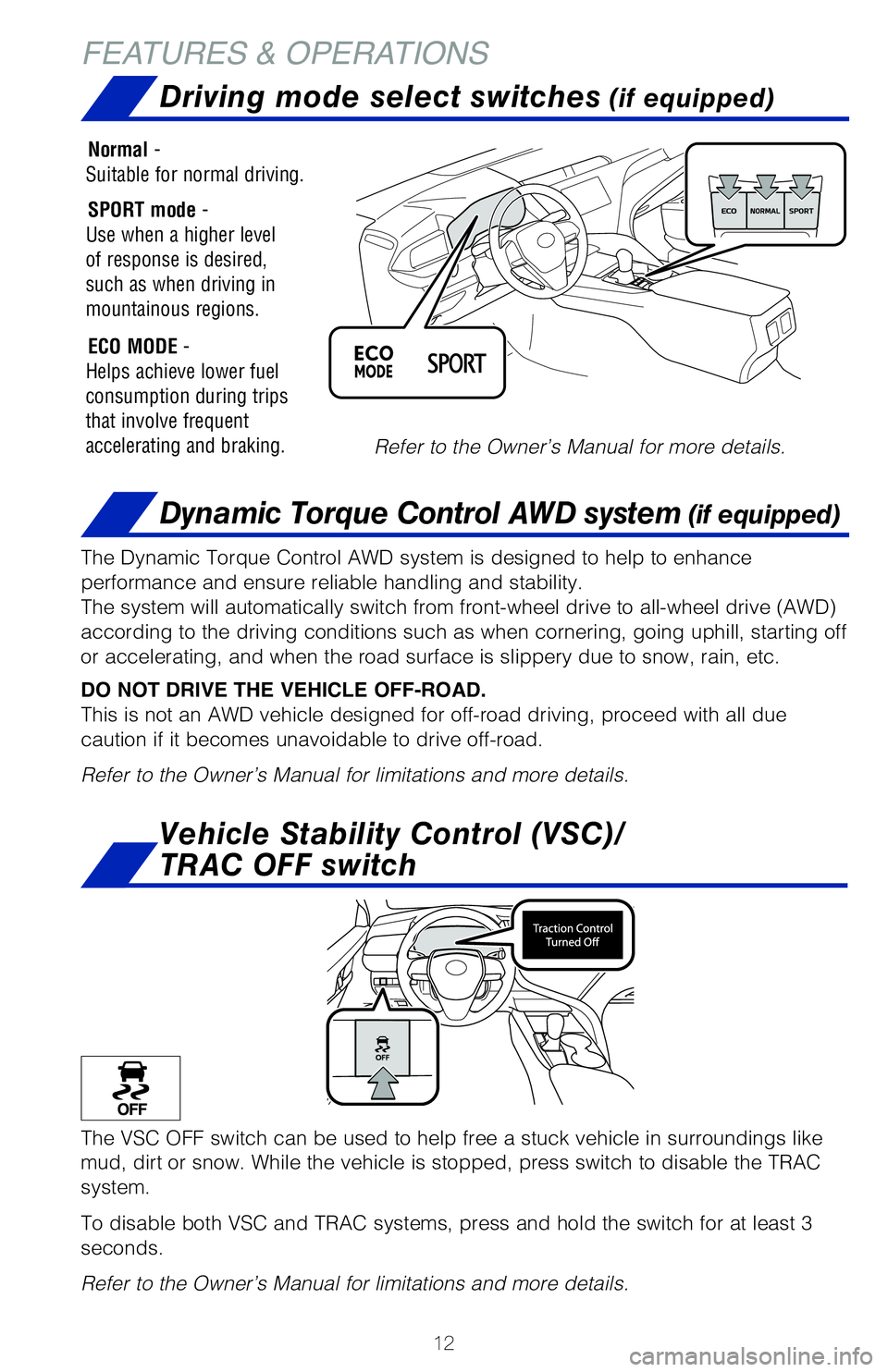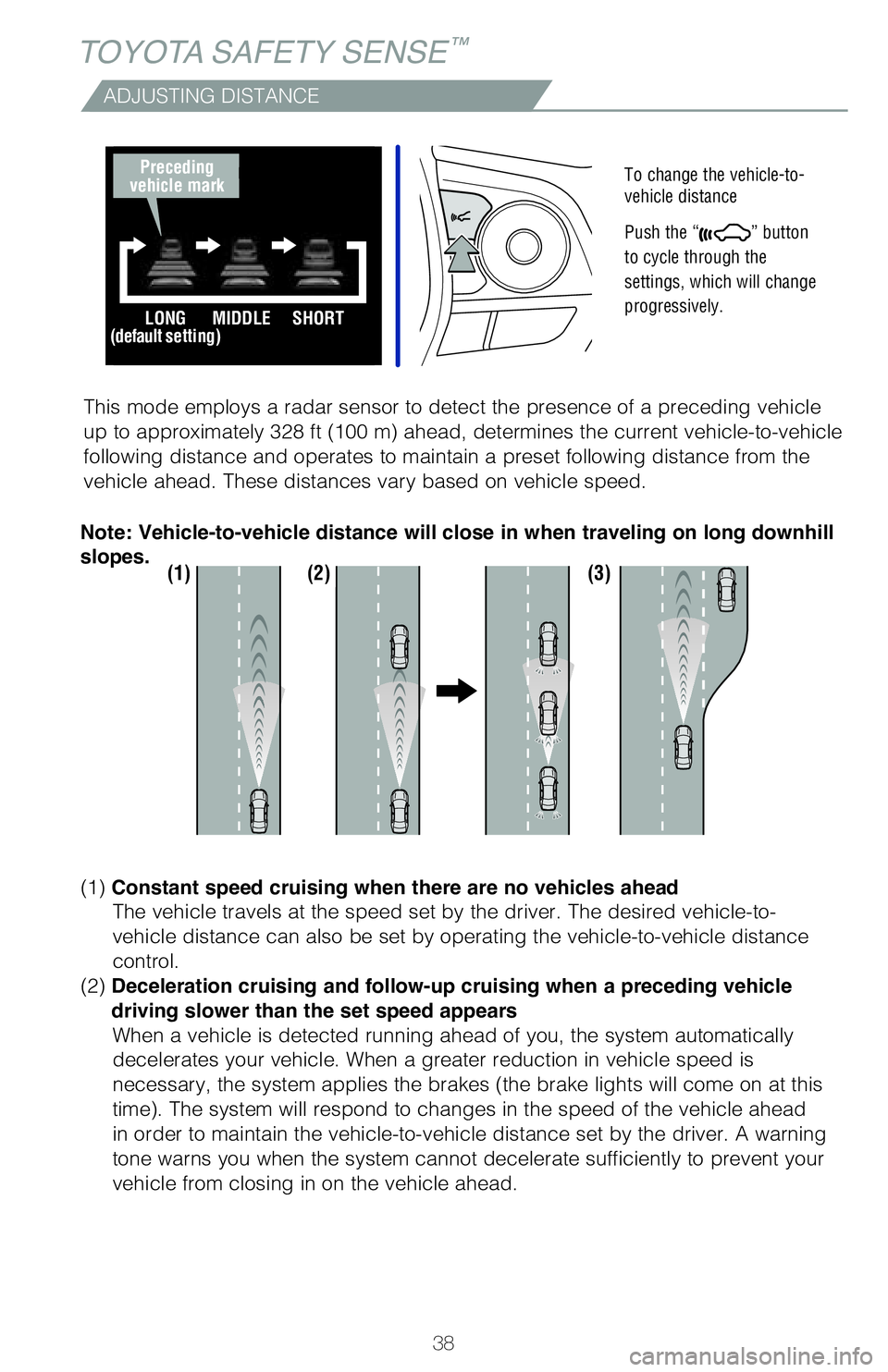ESP TOYOTA CAMRY 2020 Owners Manual (in English)
[x] Cancel search | Manufacturer: TOYOTA, Model Year: 2020, Model line: CAMRY, Model: TOYOTA CAMRY 2020Pages: 56, PDF Size: 4.29 MB
Page 14 of 56

12
FEATURES & OPERATIONSDriving mode select switches
(if equipped)
Dynamic Torque Control AWD system (if equipped)
The VSC OFF switch can be used to help free a stuck vehicle in surroundi\�ngs like
mud, dirt or snow. While the vehicle is stopped, press switch to disable\� the TRAC
system.
To disable both VSC and TRAC systems, press and hold the switch for at l\�east 3
seconds.
Refer to the Owner’s Manual for limitations and more details. The Dynamic Torque Control AWD system is designed to help to enhance
performance and ensure reliable handling and stability.
The system will automatically switch from front-wheel drive to all-wheel drive (AWD)
according to the driving conditions such as when cornering, going uphill\�, starting off
or accelerating, and when the road surface is slippery due to snow, rain\�, etc.
DO NOT DRIVE THE VEHICLE OFF-ROAD.
This is not an AWD vehicle designed for off-road driving, proceed with a\�ll due
caution if it becomes unavoidable to drive off-road.
Refer to the Owner’s Manual for limitations and more details.
Vehicle Stability Control (VSC)/
TRAC OFF switch
Normal -
Suitable for normal driving.
SPORT mode -
Use when a higher level
of response is desired,
such as when driving in
mountainous regions.
ECO MODE -
Helps achieve lower fuel
consumption during trips
that involve frequent
accelerating and braking. Refer to the Owner’s Manual for more details.
Page 34 of 56

32
TOYOTA SAFETY SENSE™
CHANGING PCS ALERT TIMING
FarMiddle
(default) Near
(1) Press “” switches and select or from the Multi-Information Display
(MID).
(2) Press “
” switches and select “Warning sensitivity” from the MID and th\�en
press “
”. The setting screen is displayed.
(3) Press “
” each time to change the setting. Each time it is pressed, the
response to the PCS alert timing changes as shown above. You can press “\�
” to
go back to the menu.
Note: PCS is enabled each time the engine switch is turned to Ignition On.
The system can be disabled/enabled and the alert timing of the system can be
changed. (Alert timing only, brake operation remains the same).
Monocular front camera
Millimeter
wave radar
As part of the Pre-Collision System, this function is also designed to f\�irst provide an
alert and then automatic braking if needed.
Refer to the Toyota Owner’s Manual for additional limitations and inf\�ormation.Under certain conditions, the PCS system included with the TSS-P package\� may
also help to detect a pedestrian in front of your vehicle using the in-v\�ehicle camera
and front grille-mounted radar. The in-vehicle camera of PCS detects a p\�otential
pedestrian based on size, profile, and motion of the detected pedestrian\�. However,
a pedestrian may not be detected depending on the conditions, including \�the
surrounding brightness and the motion, posture, size, and angle of the p\�otential
detected pedestrian, preventing the system from operating or engaging.
PCS PEDESTRIAN DETECTION
Page 40 of 56

38
TOYOTA SAFETY SENSE™
ADJUSTING DISTANCE
To change the vehicle-to-
vehicle distance
Push the “
” button
to cycle through the
settings, which will change
progressively.
This mode employs a radar sensor to detect the presence of a preceding v\�ehicle
up to approximately 328 ft (100 m) ahead, determines the current vehicle-to-vehicle
following distance and operates to maintain a preset following distance \�from the
vehicle ahead. These distances vary based on vehicle speed.
(1) (2) (3)
(1) Constant speed cruising when there are no vehicles ahead
The vehicle travels at the speed set by the driver. The desired vehicle-\�to-
vehicle distance can also be set by operating the vehicle-to-vehicle dis\�tance
control.
(2) Deceleration cruising and follow-up cruising when a preceding vehicle
driving slower than the set speed appears
When a vehicle is detected running ahead of you, the system automaticall\�y
decelerates your vehicle. When a greater reduction in vehicle speed is
necessary, the system applies the brakes (the brake lights will come on at this
time). The system will respond to changes in the speed of the vehicle ahead
in order to maintain the vehicle-to-vehicle distance set by the driver. \�A warning
tone warns you when the system cannot decelerate sufficiently to prevent\� your
vehicle from closing in on the vehicle ahead.
Note: Vehicle-to-vehicle distance will close in when traveling on long downhill
slopes.
LONG
(default setting)MIDDLE SHORT
Preceding
vehicle mark
Page 46 of 56

44
SAFETY & EMERGENCY FEATURESSafety Connect
® (if equipped)
Safety Connect is a subscription-based telematics service that uses Glob\�al
Positioning System (GPS) data and embedded cellular technology to provide safety
and security features to subscribers. Safety Connect is staffed with liv\�e agents at
the Toyota response center, which operates 24 hours per day, 7 days per \�week.
Services for subscribers include:
• Automatic collision notification
• Stolen vehicle locator
• Emergency assistance (“SOS” button)
• Enhanced roadside assistance
For additional information refer to the “Owner’s Manual” or vis\�it www.Toyota.com/
connected-services.
Rear door child safety locks
Moving the lever downward will allow the door to be opened only from the\� outside.
Rear door
Lock
Unlock
Microphone
LED Indicators “SOS” button
Page 48 of 56

46
SAFETY & EMERGENCY FEATURESStar Safety System
™
ANTI-LOCK BRAKE SYSTEM (ABS)
Toyota’s ABS sensors detect which wheels are locking up and limits wh\�eel lockup
by “pulsing” each wheel’s brakes independently. Pulsing release\�s brake pressure
repeatedly for fractions of a second. This helps the tires attain the tr\�action that
current road conditions will allow, helping you to stay in directional c\�ontrol.
BRAKE ASSIST (BA)
Brake Assist is designed to detect sudden or “panic” braking, and \�then add braking
pressure to help decrease the vehicle’s stopping distance. When there\�’s only a split
second to react, Brake Assist can add additional brake pressure more qui\�ckly than
just the driver alone can.
ELECTRONIC BRAKE FORCE DISTRIBUTION (EBD)
Toyota’s ABS technology has Electronic Brake-force Distribution (EBD) to help
maintain control and balance when braking. EBD responds to sudden stops \�by
redistributing brake force to enhance the braking effectiveness of all f\�our wheels.
Your vehicle comes standard with the Star Safety System
TM, which combines Anti-
lock Braking System (ABS), Brake Assist (BA), Electronic Brake-force Distribution
(EBD), Smart Stop Technology (SST), Traction Control (TRAC) and Vehicle Stability
Control (VSC),
Refer to the Owner’s Manual for more details and important information on limitations
to these systems.
SMART STOP TECHNOLOGY (SST)
Smart Stop Technology automatically reduces engine power when the accele\�rator
and brake pedals are pressed simultaneously under certain conditions.
SST engages when the accelerator is depressed first and the brakes are a\�pplied
firmly for longer than one-half second at speeds greater than five miles\� per hour.
SST doesn’t engage if the brake pedal is depressed before the acceler\�ator pedal,
allowing vehicles to start on a steep hill and safely accelerate without\� rolling
backward.
ENHANCED VEHICLE STABILITY CONTROL (VSC)
Enhanced Vehicle Stability Control provides cooperative control of the A\�BS, TRAC,
VSC and EPS.
Enhanced VSC helps to maintain directional stability when loss of tracti\�on occurs
during a turn.